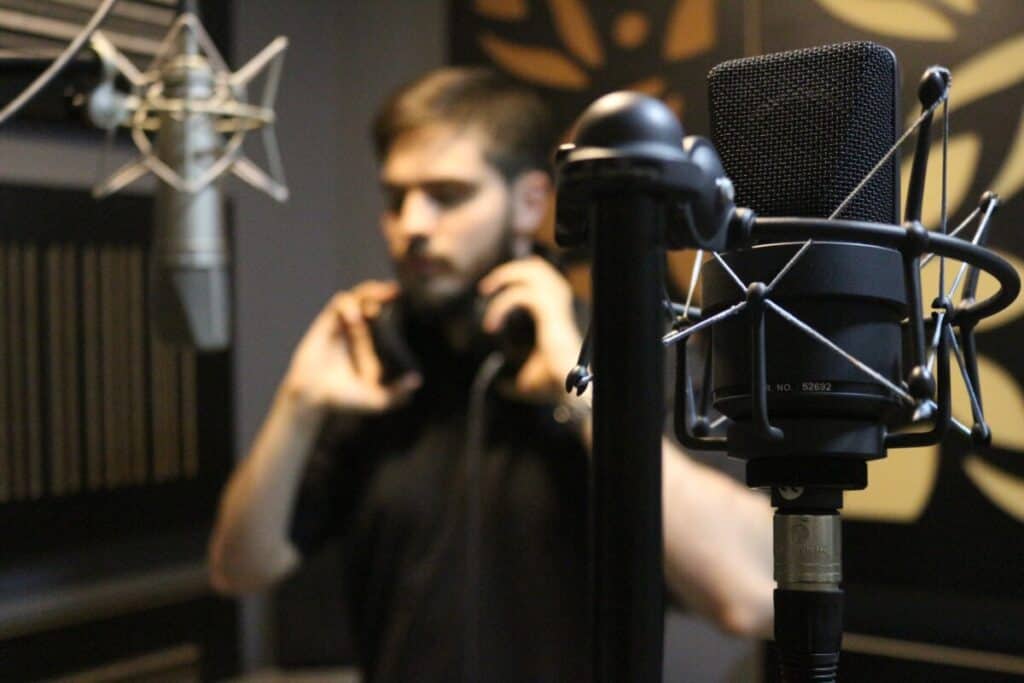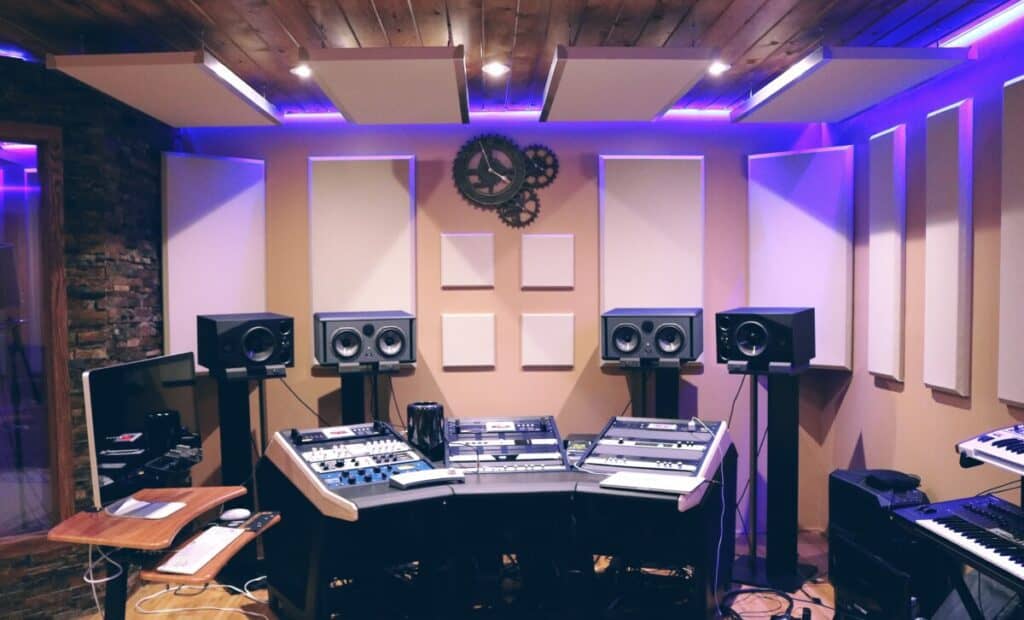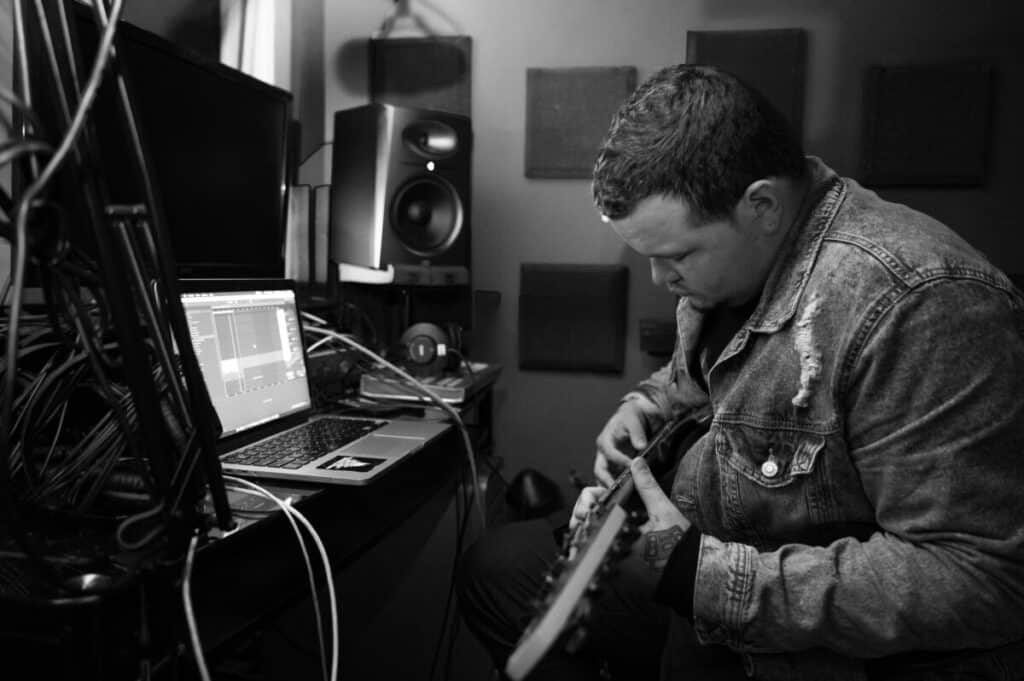When getting a recording studio, it can be challenging to determine just how large it should be to optimize sound quality while also limiting reverberation and pressure issues. While the exact dimensions you’ll need depend on what you plan to do in the space, you can follow these general guidelines to give you an estimate of how large your studio will need to be.
Recording studios should be 17.5 feet (5.33 m) wide, 10 feet (3.05 m) tall, and 23 feet (7.01 m) long at a minimum. This ratio lowers pressure issues, so you’ll have fewer problems to treat. If you can get an even larger space, do it, as bigger studios give you more options than smaller ones.
This article will look into all of the characteristics a perfect studio would encompass. Then we’ll go over the minimum size a studio should be and some other factors you should consider when determining the exact dimensions you’ll need.

Ideal Studio Characteristics
If you could create the perfect recording studio, it would be a large room with high ceilings, asymmetrical walls, and hardwood floors. These features reduce the reverberations, thereby making your recordings sound better. We will go over all of these factors below in detail:
- Large room size to help prevent unwanted reverberations. In larger studios, sound waves must travel farther to reach the walls than in smaller studios. Therefore, they lose more of their strength before they are reflected, so the reverberations they produce aren’t as powerful. So, in large studios, your mic will pick up fewer unwanted sounds than in a smaller space, making your audio clearer.
- Look for high ceilings to help with reflection issues. Having high ceilings is another way to help prevent reverberations from influencing your recordings. Lower ceilings allow for stronger reflections, which can be picked up by your mic and distort your sound.
- Asymmetrical walls for better acoustics. If you have a perfectly square or rectangular room, the sound will consistently reflect off the walls, resulting in the accumulation of frequencies in certain parts of the room. Asymmetrical rooms, however, allow the sound to bounce throughout the studio without building up in certain spots.
- Get hardwood or laminate floors instead of carpet. Hardwood and laminate floors are both reflective and generally result in excellent sound. Other acceptable flooring materials are tile and concrete. However, carpet should be avoided since it absorbs high frequencies but not low frequencies, resulting in an unpleasant “boomy” sound.

Check out my articles about recording studios:
Minimum Size a Recording Studio Should Be
So, you know your studio should be in a large room to help prevent unwanted reverberations. However, you may be wondering exactly how large the space needs to be?
According to Acoustic Fields, a great starting size for a recording studio would be 17.5 feet (5.33 m) wide, 10 feet (3.05 m) tall, and 23 feet (7.01 m) long. They arrived at this ratio using Oscar Bonello’s research. Bonello was an engineer who studied room sizes and the pressures of rooms. He analyzed the different pressure patterns and modes of different sized rooms and discovered that some room ratios were much better than others.
The ratio mentioned above is excellent because it minimizes serious pressure issues you would generally have to treat. If you have a smaller studio than this ratio, you may still be able to treat the pressure issues. The problem, however, is that treating these issues takes space. By the time you fixed the smaller room, you’d have minimal space left for recording.
If you have to go smaller than this ratio, do not get a studio that is less than 14 feet (4.27 m) in width or length or less than 8 feet (2.44 m) in height
. If you do, you’ll face some serious acoustic problems.
To learn more about this ratio and Bonello’s research, check out this video by Acoustic Fields. In the video, acoustic expert Dennis Foley goes over Bonello’s graph and how to apply it. Then, he discusses why the ratio mentioned above is a great starting point for a recording studio. Lastly, he talks about other factors you should consider when determining the ideal size for your studios, such as room usage and pressure levels:
Other Factors to Consider
Always begin your studio search by finding a space that is at least as big as the ratio mentioned above. Then, consider whether or not you can find something bigger, the room’s volume, and your planned usage of the area to determine if the studio space is right for you.
Check out my article on things to consider if a home studio is worth building.
Go As Big as You Can
Ideally, you want as large a space as possible. The minimum ratio is a good start, but it isn’t perfect.
Having a 10 foot (3.05 m) high ceiling isn’t ideal. A ceiling of this height will produce low-frequency pressure problems. So, if you can find a studio with a higher ceiling that is around 12-13 feet (3.66-3.96 m) high, that would be the better option.
Studios of a greater length and width are also preferable. The larger the studio, the more room you have to treat sound problems. Plus, you’ll have the space to accommodate more equipment and people in your studio.
Check out whether a Vocal Booth can be “too dead”.
Consider the Volume
Volume is another essential factor to consider when selecting a studio. Volume goes hand in hand with room size. To calculate your studio’s volume, multiply the room’s length, width, and height together (make sure the measurements are in feet).
After you’ve calculated the volume, compare it to this chart created by studio expert Dennis Foley. This chart lists room volumes that should avoid at all cost, the problematic volumes, and those that are treatable.
| Volume Divisions | Volume in Cubic Feet |
| Avoid at all costs | Less than 1,500 cu.ft |
| Problematic | Less than 3,000 cu.ft |
| Treatable | Less than 4,500 cu.ft |
If your room’s volume falls into the “avoid at all cost” category, do everything in your power to find a different space. If your studio falls into the “problematic” category, you may be able to treat it depending on what you plan to use the room for (more on this below).
For more information, check out: Gain Vs Volume Explained
Think About the Usage
The exact dimensions you’ll need for your studio vary depending on what you plan to do in the space. For example, if you plan to use the studio as a live room where you’ll have four musicians playing simultaneously, you’ll need more space than if you want to use it as a control room, voice room, or listening room.
The minimum ratio mentioned above is an ideal starting point for your studio. However, these dimensions should be adjusted depending on your goals and what you plan to achieve in the space.
You have to be realistic and select a room that’ll be large enough to accomplish your current and future goals. If you dream of expanding your studio in the future, you need to start big, so you’ll have room to grow.

Ventilating your recording studio will be important, find out more in this article here!
Conclusion
Try to find a recording studio that is at least 17.5 feet (5.33 m) wide, 10 feet (3.05 m) tall, and 23 feet (7.01 m). This room size lessens pressure issues and large enough to fit recording equipment.
However, the dimensions you’ll need maybe larger than this, depending on your needs in your studio. For example, if you plan to use it for live recordings, it needs to be larger than if you plan to use it as a control or listening room.
We hope this article helps you find the perfect studio with ideal dimensions.
Sources
- Essential Home Studio: Go Big Or Go Home – Do You Really Need A Big Room For A Recording Studio?
- E-Home Recording Studio: Recording Studio Design 101: How to Set Up Your Room
- Musika: Testing Room Acoustics for Musicians
- YouTube: Acoustic Fields: Ideal Room Size Ratios & How To Apply The Bonello Graph – www.AcousticFields.com
- Youtube: Acoustic Fields: Room Size & Volume – www.AcousticFields.com
- Acoustic Fields: How To Apply The Bonello Graph In-Room Acoustics
- Acoustic Fields: What Is An Ideal Control Room Dimensions Ratio?
- Frangioni Media: How Professional Recording Studios Are Designed for Superior Sound
- Sweetwater: Purpose of hardwood floors in studios
Recent Posts
QuickTime is a vital app for many Mac users, and if you’ve recently bought a new microphone, you might wonder how to use it optimally. QuickTime cannot record audio content if it doesn’t have...
Every microphone leaves a unique signature on the quality of its output. If you’re a podcaster trying to melt your way into your audience’s hearts, a muddy, distorted recording won’t cut it....
